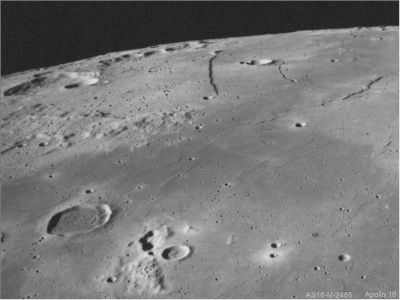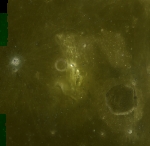Lassell
Contents
- 1 Lassell - and Garcia-Gomez (Alpetragius B) east-northeast of it
- 1.1 Images
- 1.2 Maps
- 1.3 Description
- 1.4 Description: Elger
- 1.5 Description: Wikipedia
- 1.6 Additional Information
- 1.7 The Lassell Massif: remarkable color difference near Lassell C
- 1.8 The Cinder Cone near Lassell D and Lassell J
- 1.9 Nomenclature
- 1.10 LPOD Articles
- 1.11 LROC Articles (the yellowish colored Lassell Massif)
- 1.12 Bibliography
- 1.13 William Lassell in the Sourcebook Project (William R. Corliss)
Lassell - and Garcia-Gomez (Alpetragius B) east-northeast of it
| Lat: 15.5°S, Long: 7.9°W, Diam: 23 km, Depth: 0.9 km, Rükl: 54 |

Apollo 16, AS16-M-2485 In this southward-looking oblique view, Lassell is the large polygonal crater in the lower left. To its right (west, adjacent to the hilly area known as the somewhat yellow colored Lassell Massif and the deeply-shadowed craters Lassell G and K) is 9-km Lassell C, followed by the pair Lassell D (bright) and J (normal), and finally by 5-km Lassell H in the lower right. In the far distance is the dark line of Rupes Recta, and to its right Birt, Rima Birt and an unnamed mare ridge.
Images
LPOD Photo Gallery Lunar Orbiter Images Apollo Images
- Lassell was also captured near the leftmost margins of Apollo 16's orbital panoramic ITEK-camera frames AS16-P-5396 and AS16-P-5401.
- Research orbital Apollo 16 photography: Danny Caes
- Terrestrial telescopic color-photographs of the Lassell region show a curious yellowish coloration at the low hills near Lassell C (the Lassell Massif). This phenomenon was noticed by the astronauts of Apollo 16 (see Additional Information below). See also LPOD Spotted Moon (telescopic color photograph by Michael Hunnekuhl).
Maps
(LAC zone 77D4) LAC map Geologic map LM map
Description
Description: Elger
(IAU Directions) LASSELL.--This ring-plain, some 14 miles in diameter, is irregular both as regards its outline and the width of its rampart. There is a crater on the crest of the N.E. wall, just above a notable break in its continuity through which a ridge from the N.E. passes. There is another crater on the opposite side. The central mountain is small and difficult to see. About 20 miles N.W. of Lassell is a remarkable mountain group associated with a bright crater, and further on in the same direction is a light oval area, about 10 miles across, with a crater (Alpetragius d) on its S. edge. Madler described this area as a bright crater, 5 miles in diameter, which now it certainly is not.
Description: Wikipedia
Additional Information
- Depth data from Kurt Fisher database
- Pike, 1976: 0.9 km
- Arthur, 1974: 0.92 km
- Westfall, 2000: 0.9 km
- Viscardy, 1985: 0.91 km
- Cherrington, 1969: 0.94 km
The Lassell Massif: remarkable color difference near Lassell C
Noticed and described by CMP Ken Mattingly during the mission of Apollo 16:
- 147:59:22 Ken Mattingly: I'm looking at Lassell C and the little highlands clump that's by it. And - remember, we had a red and a blue color difference, and right now the Southern Pease with a crater in it is sort of a - a tan color, and the Northern Pease is a gray. When I look at the mare, I see a big swatch of - of the tan-colored mare down to the south that goes over towards Guericke. And I see a - a tongue of darker gray material. The area around Lassell C has the tan tone to it. Then it goes out about as far as our little cone and the little bright crater next to it. That's about the outer limit - maybe just a little beyond. Then there's a patch of the - of this tan stuff that's down to the south that about lines up with the big Achaean rille that's over to the southeast. Then there's a patch in the gray-colored mare down inside of that. It's just a little circular piece. In looking at the Lassell C feature - a look at it in detail - it appears to me that this tan stuff on the south end of it has fewer craters than the stuff on the north, although not an awful lot, but there's little pitted craters all over the northern part. They're not on the southern parts and there are a couple of light, streaked bands that appear in the southern clump that you don't see in the north.
Source: Apollo 16 Flight Journal by David Woods and Tim Brandt.
- Note: In the preceding, "Southern Pease" and "Northern Pease" appear to be transcription errors for "southern piece" and "northern piece". The coloration near Lassell C is also noticeable through telescopes on Earth. Many photographers have made interesting RGB-images of this remarkable colored spot.- DannyCaes Jul 28, 2008
Clementine UV-VIS Multispectral Mosaic: Mercator projection dynamically created by USGS lunar Web Map Service. Click here for a USGS-generated list of all IAU-named features with centers in this field. Lassell D is the bright blue object on the left, Lassell C is the circular ring just to the left of center, and Lassell itself is the larger ring in the lower right.
- See also the LROC's WAC albedo/color map; close up of the Lassell C region: http://bit.ly/1xbMvgV
The Cinder Cone near Lassell D and Lassell J
- The bright ray-craterlet Lassell D, the common bowl-shaped craterlet Lassell J, and the unusually dark craterlet southwest of Lassell D and J (the so-called Cinder Cone) are described and depicted in NASA SP-362; APOLLO OVER THE MOON; A VIEW FROM ORBIT, Chapter 4: The Maria (Part 3), Figure 88 (two versions of orbital Hasselblad frame AS16-120-19237: a small one and an enlarged detailed view of the three craterlets as a cluster).
- The unusually dark craterlet (the Cinder Cone) southwest of Lassell D and J is an excellent test object for telescopic observers of the Full Moon. - DannyCaes Aug 23, 2015
- According to several dedicated moonobservers of the past, the bright ray-craterlet Lassell D appears to be of the same nature as Linné, Posidonius Gamma, and Werner D (possible changes of brightness in their ejecta-blankets). - DannyCaes Aug 23, 2015
- Most of today's photographers of the Full Moon's disc are unaware of the Cinder Cone's dark appearance on their webcam images. But... once they know the pinpoint location of it, they can't miss it! Good luck! - DannyCaes Mar 23, 2008
- Satellite crater Lassell D is on the ALPO list of bright ray craters and on the ALPO list of banded craters (note: Lassell D is only 2 km in diameter)
Nomenclature
- Named for William Lassell (1799-1880), a beer brewer and British astronomer noted for his self-built reflecting telescopes to 48-inches diameter, and his discovery of several planetary moons.
- According to Whitaker (p. 205), the area around Lassell, including Lassell C was named Insula Lesbos by Hevelius.
- The present name was part of the original IAU nomenclature of Blagg and Müller (1935), and, according to Whitaker (p. 221) had been introduced by Birt and Lee.
- Alpetragius B, immediately east-northeast of Lassell, was once known as Garcia-Gomez. This was one of the many discontinued names from H.P.Wilkins and P.Moore (see their book The Moon).
LPOD Articles
New Observations of a Well-Known Area Spotted Moon
LROC Articles (the yellowish colored Lassell Massif)
Bibliography
- Joseph Ashbrook. 1984. "The Telescopes of William Lassell". Chapter 27 (pp. 136-141) in The Astronomical Scrapbook; reprinted from Sky and Telescope (October, 1959), p. 664.
- Harold Hill. 1991. A Portfolio of Lunar Drawings, pages 102, 103 (Lassell and environs).
William Lassell in the Sourcebook Project (William R. Corliss)
- In Mysterious Universe, a handbook of astronomical anomalies (1979) :
- Page 434: The Periodicity of Jupiter's Markings (William Noble, Observatory, 1895).
- Page 464: A Ring around Jupiter? (New Scientist, 1964).
- Page 495: Ring of Neptune (Astronomische Nachrichten, 1847).
- Page 496: Neptune, its supposed ring and satellite (American Journal of Science, 1847).
- Page 496: Reflections concerning Neptune's ring (William G. Hoyt, Sky and Telescope, 1978).
